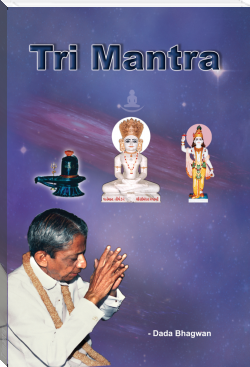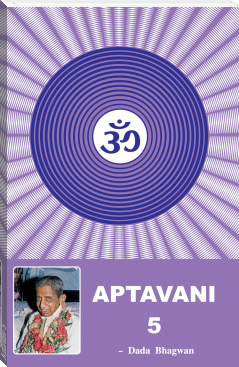The Science Of Karma, Dada Bhagwan [red white and royal blue hardcover TXT] 📗

- Author: Dada Bhagwan
Book online «The Science Of Karma, Dada Bhagwan [red white and royal blue hardcover TXT] 📗». Author Dada Bhagwan
The karmas that one binds, such as ‘to eat, drink and be merry, are called sanchit karmas, or accumulated karmas. Such karmas are stockpiled at a subtle level and when they are about to ripen and give fruits, a person is inspired to eat unhealthy food and when he is done eating it is called prarabdha karma (fate). This in turn gives a final result, which is the effect of effect so that he may end up having dysentery and become sick. That is kriyamana (exhausted resultant) karma.
Param Pujya Dadashri shows us that Vyavasthit Shakti includes the principles of karma. Karma is only a small fraction of Vyavasthit, it doesn’t include the total process. Karma belongs to Vyavasthit but Vyavasthit does not belong to karma. Karmas are carried on in a subtle form as seeds from the past life. However, it does not end there. When the karma starts producing fruits, (i.e., trees grow from the seeds) so many circumstances are required. The seed becomes a mango tree and one can receive mangoes. This process involves many other evidences such as, soil, water, sunshine, fertilizer, heat and time. Dadashri has explained beautifully, that these are the fruits of karma. The seeds of karma are active at the very subtle level.
Many people ask how the first karma was bound. Did the body come before the karma? Did the chicken come before egg? It is all the same. In reality, there is no such thing as the first karma in the world. Karma and Atma have existed throughout time without a beginning or an end. Karmas are charged atoms. The Atma is the living or conscious tattva (element). Both tattvas (atma and matter) are always separate. Atattva is an eternal element. How can there be a beginning to that which is eternal? All karmas are charged because of the union of the living ( chetan) and non-living (jada). It is the seed karma (cause or charge karma), which gives the fruit of karma (effect or discharge karma) in the next life. Karmas produce circumstances that by nature are temporary. Union is followed by separation. Circumstances come and go, giving rise to various stages of existence and events. When the wrong belief, “I am this and this is mine,” arises it results in the visible and tangible worldly life. If one understands this mystery then there is only the Shuddhatma (Pure Soul) and sanyog (circumstance). Owing to the lack of such understanding we use the gross language of prarabdha and call it fortune, fate, or destiny, etc. The science however tells us this much, that if we remain separate from the evidences, then we can stay in the Atma and only then, karma does not exist.
How does one bind karmas? Karmas are bound by the subtle belief of doership in any action.
What is doership bhaav? When someone else does the karma and one believes that “I am doing it” is called doership-karta bhaav.
ImprintText: Dada Bhagwan Aradhana Trust
Images: Dada Bhagwan Aradhana Trust
Publication Date: 07-07-2017
All Rights Reserved





Comments (0)